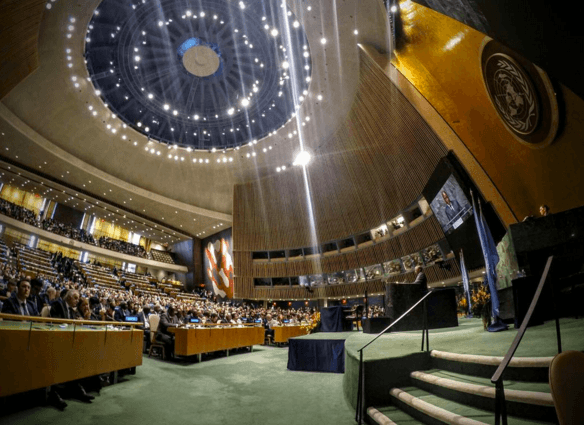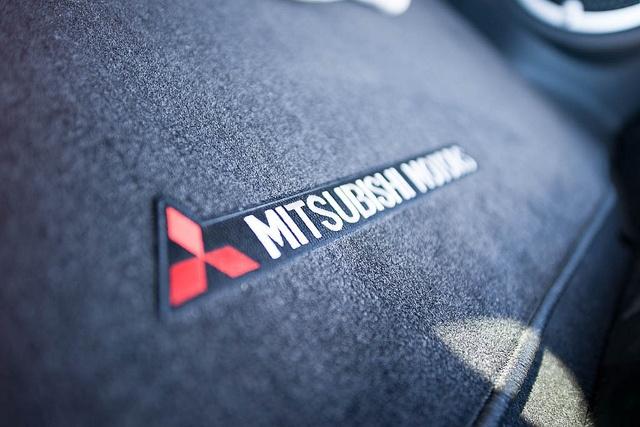3p Weekend: Your Cheat Sheet to the Paris Agreement Signing


With a busy week behind you and the weekend within reach, there’s no shame in taking things a bit easy on Friday afternoon. With this in mind, every Friday TriplePundit will give you a fun, easy read on a topic you care about. So, take a break from those endless email threads and spend five minutes catching up on the latest trends in sustainability and business.
The big news this week is an Earth Day ceremony at the U.N. headquarters in New York, where world leaders were invited to formally sign the Paris Agreement.
Experts tracking the agreement closely are riveted with the development. But those of us who aren't as familiar with the bureaucratic inner workings of the U.N. Framework Convention on Climate Change (UNFCC) may still have more questions than answers.
Since no one wants to be a step behind at the office happy hour, we gathered up a cheat sheet to today's signing ceremony and what's next for the Paris Agreement. Read on to get informed quickly, and maybe impress the boss while you're at it.
Wait, didn't we just do this in December?
In short: No. The big news on Dec. 12 that prompted cheering and champagne-popping was the formal "adoption" of the Paris Agreement by the U.N. Conference of Parties (COP). This is just a fancy way of saying that all parties present at the COP21 climate talks in Paris agreed on the language of the agreement and what would happen next.
Okay, so what happens now?
Today's events are the next step in the agreement's journey. Earth Day, April 22, marked the first day that world leaders were able to formally sign the agreement -- hence the hoopla in New York.
Leaders from all 195 countries present at COP21 were invited to the U.N. headquarters for the official signing ceremony, and the World Resources Institute reports that 175 made the trip. The signing period will stay open for a year, until April 21, 2017 (other leaders are expected to sign between now and then).
Keep in mind that the pen-to-paper aspect of signing the agreement is purely ceremonial. To officially join the agreement, nations must issue their formal "instruments of ratification" -- which is a fancy way of saying they agree to be bound by the terms of the agreement. And no, this isn't as simple as a head of state's "okay."
Most countries will sign the agreement “subject to ratification, acceptance and approval,” making their signature conditional on obtaining the required domestic approval for joining the agreement, the World Resources Institute (WRI) reports. In some countries, like Australia, this is as simple as presenting the agreement before Parliament. Others, like Mexico, require Senate approval. The U.S. can enter into "executive agreements," which -- with gridlock in Congress -- is the most likely scenario.
After heads of state jump through their respective legal hoops, they then return to the COP and issue their instrument of ratification, also called an instrument of "ratification, acceptance and approval,” to officially become parties to the agreement.
Who signed?
At a press conference this afternoon, U.N. Secretary General Ban Ki-moon announced that 175 nations signed the agreement in New York, the WRI reports. These signatories include the world's top three greenhouse gas emitters: the U.S., China and the EU. India, the world's No. 4 emitter, was a question-mark going into the proceedings, but the South Asian nation also agreed to sign. As did Russia, another country many analysts weren't sure about.
Most of these signatories will go back home to gain approval for the agreement before formally ratifying. Only 15 parties formally joined the agreement in New York today. Representing a mere 0.04 percent of global emissions, the vast majority of these joining states are small island nations, including the Maldives, Palau, Fiji and 11 Caribbean states, as well as Somalia in East Africa.
Is the agreement now legally binding?
Again, not so fast. In order for the agreement to go into effect and become legally binding, at least 55 countries representing 55 percent of global emissions need to formally join. Only 15 nations ratified today, and they represent a small sliver of emissions, so we still have a long way to go.
The signing period will be open for a year, and the states that signed today can formally join the agreement any time during that period. In the chart above, the World Resources Institute details three possible scenarios in which we could meet the ratification target.
To keep tabs on the progress of the agreement, who's signing and who's joining, check out this interactive tracker from the WRI. The institute is also live-blogging the proceedings all day, so keep an eye on this page for up-to-the-minute announcements.
So, then why is everyone making such a big deal of this?
No one expected us to reach the target of 55 joining nations today, but experts agreed that a strong showing of signatories was crucial to the long-term success of the agreement.
The 175 heads of state who opted to sign outpaced almost all estimates. And get this: It's the largest number of representatives who have ever signed an international agreement on the day of a signing ceremony, the WRI reports.
"When all is said and done, today will be the largest one-day signing event in the history of the U.N.," U.S. President Barack Obama said in a statement this afternoon.
The future of the Paris Agreement
“The climate focus now pivots from diplomacy to implementation," said Andrew Steer, president and CEO of the World Resources Institute.
These signing nations have already submitted their plans to implement the agreement, legally dubbed their intended nationally determined contributions (INDCs). Now, they have to gain approval from their respective governments and begin enacting policy to make good on their promises. This will present significant challenges, and we can't rest on our laurels, experts said.
"The challenge is to find ways to work together to accelerate the work already begun by national governments, mayors, CEOs, civil society groups and citizens around the world. As more than 20 countries have shown, we can grow our economies without also increasing emissions," Steer said.
Others added that, while the pledges made by governments are a great start, they don't go nearly far enough to limit global emissions and help vulnerable populations adapt to climate change.
“If all of today’s public climate adaptation finance were to be divided among the world’s 1.5 billion smallholder farmers in developing countries, they would get around $3 each a year to cope with climate change,” Winnie Byanyima, executive director of Oxfam International, said in a statement.
The good news is that governments are rising to the challenge. Some noteworthy announcements include:
- Canadian Prime Minister Justin Trudeau plans to crowdsource climate action solutions with a new online platform.
- New York City Mayor Bill de Blasio announced that every new car the city government purchases will be an electric vehicle. And all new buildings constructed in New York City will be required to be 60 to 80 percent more efficient than current buildings.
- Liu Zhenya, chairman of the State Grid Corporation of China, said he expects renewables to represent 80 percent of China's total energy consumption by 2050.
- More than 80 Muslim leaders presented the Islamic Climate Change Declaration before the U.N. and created the Global Muslim Climate Network, which pledges to mobilize the Muslim community around climate action.
More will likely trickle in throughout the day, so keep an eye on WRI's live blog for updates.
While the road ahead may be long and bumpy, today's strong showing should banish any worries that Paris would become another Copenhagen.
As former U.S. Vice President and climate action figurehead Al Gore put it: The "historic journey" to eradicating climate change begins today.
Image credits: 1) United Nations via Instagram 2) and 3) Courtesy of the World Resources Institute
Mitsubishi Raided After 'Intentional' Tampering with Fuel Mileage Tests


Investigators from Japan's Transport Ministry raided a factory belonging to Mitsubishi Motors in the Japanese city of Okazaki on Thursday. The raids came after the company admitted that employees manipulated fuel-efficiency test results in more than 600,000 of its popular mini cars.
The news was immediately felt on the stock market. By Friday morning, Tokyo time, Mitsubishi shares had plunged more than 30 percent, wiping out more than $2 billion in market value.
The higher fuel-efficiency ratings meant the cars, most of which were sold by Nissan, were eligible for government-backed rebates. Nissan discovered the test discrepancies, prompting Mitsubishi to admit that employees had been tampering with the test results and that the deception was "intentional."
If Mitsubishi is found guilty of modifying test results, the company could be required to pay back the rebates customers received and may face hefty fines.
So far, the affected cars only appear to have been sold in Japan. The list comprises four mini car models: the Mitsubishi eK Wagon and eK Space, as well as the Nissan Dayz and Dayz Roox.
The news that Volkswagen may be required to fix or buy back as many as 600,000 vehicles involved in the "dieselgate" scandal in the U.S. and Canada may be contributing to Mitsubishi's plummeting stocks. It took eight months for the German automaker and government officials to reach an agreement, which will likely include billions of dollars in fines.
An analyst from the Tokai Tokyo Research Center admitted that the markets have "become very sensitive to such kinds of news," and that although the two scandals are distinct, the timing of Mitsubishi's admission may not bode well for the company. “It may have a similar impact in terms of sales and the company’s reputation,” Seiji Sugiura explained.
This isn't the first scandal to engulf Mitsubishi in recent years. In 2002, the company was accused of covering up a defect that eventually lead to the death of a pedestrian. The automaker was only now emerging from the scandal, in which it was forced to admit that it publicly blamed drivers for a problem it new was a safety defect.
Image credit: Flickr/Mitsubishi Photos
Volkswagen to Buy Back Cars in U.S., Europe Deal Still Frozen


With only days to go before the deadline, Volkswagen AG (VW) and the U.S. government reached a partial settlement over how to deal with the automaker's "dieselgate" emissions scandal.
Volkswagen agreed to fix or buy back some 500,000 vehicles caught up in the crisis. What wasn't agreed upon is how much the company should pay in fines and compensation to consumers affected by the crisis.
Under the tentative agreement, VW will give the option of a fix or buy-back (at the company's expense) to owners of affected 2.0-liter engine cars. Discussions are ongoing as to how to address Audi and Porsche 3.0-liter vehicles that also contain the illicit software. Kelley Blue Book estimated that the cost to buy back and fix affected vehicles could be around $7 billion, the New York Times reported.
In November, the California Air Resources Board (CARB) announced that VW included three emissions-control systems in its high-end Porsche and Audi models that it had not disclosed to authorities. One of them was the emissions software that was later implicated in the "dieselgate" scandal relating to VW 2.0 engines. Audi has been working with CARB officials in past months on how it can best address the issue.
Just how much VW will be required to spend on fixing vehicles, compensating owners and addressing penalties has not been released, pending final agreement of the plan. U.S. District Court Judge Charles Breyer, who is overseeing the complex negotiations, said this week that the agreement would include "substantial compensation."
Germany's Die Welt newspaper reported on Wednesday that affected U.S. car owners would get $5,000 in compensation as part of the deal, citing an unidentified source. But neither Volkswagen AG nor the court would confirm the information.
While government fines could amount to almost $20 billion, financial experts say they expect the penalties to be considerably lower, but they are still being worked out.
Volkswagen stock rose 6 percent today on the European market following the announcement of the deal, a sign of much-needed optimism by shareholders that VW may be able to emerge from the scandal.
The announcement brought relief in Canada, as well, after VW Canada said the U.S. agreement will also apply in places Vancouver and Toronto, where diesel cars amount to an estimated 20 percent of the car manufacturer's Canadian sales. A VW spokesman said the U.S. agreement leads the way for similar arrangements for some 100,000 vehicles in Canada.
"Rest assured that what happens in the U.S. will be mirrored in Canada,” said Thomas Tetzlaff, a spokesman for VW Canada.
European owners, however, aren't so happy. Less stringent European emissions standards have caused long waits and mounting frustration for car owners. Even though VW offered affected car owners a quick software fix, Germany's Federal Motor Transport Agency says the plan is still under review.
Meanwhile, lawyers representing thousands of car owners argue that the U.S. agreement should stand for all consumers worldwide.
"[German Volkswagen consumers] are the backbone of the company," argued Julius Reiter, an attorney with the German firm Baum Reiter & Collegen. A final deal is still on hold in Europe.
Image credit: Flickr/Nico Nic
Solar Shocker: SunEdison Files for Bankruptcy


SunEdison filed for bankruptcy protection in New York on Thursday, in quite the Icarian fall for a company that less than a year ago was valued at over $10 billion.
The Missouri-based company was long considered the flexed bicep muscle symbolizing the clean energy sector, which keeps growing despite the removal of government-sponsored financial incentives and the current cheap price of fossil fuels. With its programs that promoted diversity and the hire of military veterans, SunEdison was shining as a success story for the “green jobs” movement that shouted loudly worldwide as many citizens lost their jobs during the 2008-2009 global fiscal crises.
But it was apparent that SunEdison’s big bicep was largely fueled by inflated, artificial and steroid-like growth. The acquisition of firms such as First Wind and Vivint Solar concerned analysts who saw that $4.6 billion buying spree correlate with a rapid spike in SunEdison’s debt-to-equity ratio.
Last fall, the company laid off approximately 15 percent of its workforce in an attempt to correct course and make the company more efficient. The transaction involving Vivint ended up failing, and that company is now suing for damages based on the financial benefits its stockholders expected from SunEdison’s planned acquisition.
Meanwhile, the Securities and Exchange Commission (SEC) launched an investigation based on suspicions that SunEdison’s executives exaggerated its liquidity. Analysts largely suggested that SunEdison’s estimated $1 billion in cash on-hand was more like only $100 million. In an amended 10-K registered with the SEC, the company said the problem stemming from such discrepancies became evident due to an “identification by management of material weaknesses in its internal controls over financial reporting.” By late September, the company found itself shouldering a staggering debt of over $11.6 billion.
In a press statement issued yesterday, SunEdison said it would file for Chapter 11 bankruptcy in order to tackle that mountain of debt. The company’s CEO, Ahmad Chatila, offered investors the usual Pablum that SunEdison “will be in an even better position over the long term” and regain its status as a leader within the renewables sector. The company claims that it has so far secured $300 million in financing in order to start restructuring its debt.
As for the yield-cos that SunEdison founded, TerraForm Power and TerraForm Global, those firms are not part of the Chapter 11 filing. Established by SunEdison to buy power plants the company had already established in order to generate new sources of cash, both companies have performed disappointingly on the securities markets, as Bloomberg notes that investors’ interest in purchasing stock in yield-cos has been on a steady decline. These same firms also became wary of SunEdison’s finances. In an investor notification filing (8-K) registered with the SEC last month, TerraForm Global complained that SunEdison’s potential bankruptcy could have a negative impact on its future performance.
Many in the news media are depicting SunEdison’s foibles as the symptom of a young industry struggling to get its sea legs up. But as Jenny Chase of Bloomberg New Energy Finance (BNEF) stated, SunEdison’s failures are more about lax corporate governance and poor strategy than the clean-energy industry’s performance and potential.
“What has distinguished SunEdison,” said Chase in an op-ed on BNEF’s website, “has been the relentless and unfocused pursuit of growth, in which it has invested vast amounts of borrowed money.”
Size mattered to SunEdison’s executives, but reckless ambition has shrunk the company’s stature amongst its peers in the renewables sector.
Image credit: SunEdison
Climate Action: Steps Toward a Great Transition


Arguably one of the most important things to come out of the COP21 climate talks in Paris last December, aside from the Paris Agreement itself, is the signal sent solidifying the growing shift in the global consciousness. We seek a transformative path forward into the new century. But any desired transformational change requires both the vision for a long-term outcome and a mechanism to achieve that outcome in the ongoing grind of our day-to-day reality.
In a globalized economy powered by fossil fuels, embedded in that reality is the expectation of ceaseless energy to drive nearly every aspect of our lives, at least for some of us. The rest must live either in the shadow of the waste and destruction brought as a consequence of a fossil-fuel-energy economy or start out on their own quest to catch up. Many suffer. Some even resort to violence and anarchy in their desperation.
The Paris Agreement sets in motion a renewed sense of urgency in our aspiration for climate action specifically and a more equitable and sustainable society in general. The more cynical among us might suggest we've heard all this before: half-hearted calls to action that bear little change, leaving the rhetoric in the dustbin of broken promises and hardened souls. It's easy to be cynical.
What is harder is to accept the failures of the past, the circumstances of the present and challenges of the future, and to determine that change is not only inevitable, but that we can also shape it toward a desired outcome. This is the promise of the Paris Agreement.
Choosing our future scenario
In an essay entitled Great Transition: The Promise and Lure of the Times Ahead, three classes of future scenarios are outlined, each with two variants. First is the Conventional Worlds scenario, then Barbarization and finally Great Transitions. Each scenario is characterized respectively by essential continuity, fundamental yet undesirable change, and fundamentally favorable social transformation.
The two variants to Conventional Worlds are "market forces" and "policy reform." The market forces variant assumes no real deviation from business-as-usual, suggesting an eventual deterioration into one of the two variants of Barbarization, either "fortress world" or complete "breakdown." On the other hand, the policy reform variant of the Conventional Forces scenario, working in the spirit of Keynes and Bruntland, offers the possibility of progress toward a Great Transition scenario. Here we have an "eco-communalism" or "new sustainability paradigm" worldview.
Some may pine after a world of eco-communalism rooted in "pastoral romance, human goodness and the evil of industrialism." But the authors suggest the more likely and desirable possibility, given our present situation, is a new sustainability paradigm. This is a world built out of a philosophy of sustainability as progressive global social evolution organized around human solidarity, new values and "the art of living."
Whether we end up in a scenario of Barbarization or Great Transformation, I argue that one thing is apparent: From our current perspective of Conventional Worlds, we have a choice, even if that choice is making no choice at all (or muddling through, as the authors in the essay define as the last option). By default that will almost certainly lead to a fortress world or complete breakdown.
Our best choice from here is one of policy reform, defined by growth and environmental equity achieved through stewardship, better technology and management. The framework set in place through the Paris Agreement, as well as the Sustainable Development goals, is the first step toward policy reform in a Conventional World that might lead to the Great Transition of a new sustainability paradigm.
World Bank Group Climate Action Plan: Policy reform for favorable transformation?
The World Bank Group announced its Climate Action Plan earlier this month. The plan builds on the foundation of the Paris Agreement, reinforcing the ambitions of individual countries and the global community toward new policies for every sector of society.
Through capacity building, leveraging resources and creating a framework of transparency, the World Bank's Climate Action Plan is an example of how we can get from here (a conventional world committed to policy reform) to there (a Great Transformation rooted in human solidarity and global social evolution).
Of course, it can be difficult to hold in our mind's eye what this transformation will look like, and this is only a small step on the road to get there. But we must look at each step as part of the whole and keep in our hearts and minds the ambition and vision set forth in Paris.
This post first appeared in GlobalWarmingisReal
Image credit: Flickr/Stephan Ridgway
Infographic courtesy of the World Bank Group
Why Do We Still Bother with the Penny?


They say, “a penny for your thoughts,” but most of us can’t be bothered to even think for that low of a price. The same goes for bending over to pick one up from the ground: Even a former director of the U.S. Mint advises not to waste your time as “you’re getting paid less than minimum wage for your trouble.”
It makes little economic sense to mint pennies. In recent years, the cost to mint a single penny, which are made almost entirely with zinc, has varied from its current 1.4 cents to 2.4 cents five years ago; the collapse in global commodities prices is largely behind its recent decrease in price.
It also costs far more to make a nickel than its actual worth, but unlike pennies, nickels stay in circulation for years. Most of us find pennies annoying, so they sit in a jar somewhere, out of circulation. Try getting rid of them, like I do when I buy a few things at the supermarket across the corner and watch the dirty looks pile on, as if I were holding up the checkout line by writing an old-fashioned check. Nevertheless, retailers need them to make change, which in turn leads banks to request more pennies, so the U.S. Mint keeps churning them out — at a cost of $144 million in 2014, as reported by the Wall Street Journal.
So, despite the fact that more transactions are processed electronically — 75 percent, reports CNBC — pennies are still accumulating in our mason jars, old ashtrays and between sofa cushions. Much of this is because of the phantom organization Americans for Common Cents (ACC), which makes the claim that pennies have the support of the majority of Americans — as in, yes, the same ones who hoard them because they don’t know what to do with them.
Claiming that pennies are critical to everything from memorizing Abraham Lincoln to raising funds for leukemia patients, ACC insists that 68 percent of us want the penny, according to a poll conducted, rather conveniently, by the ACC. The organization's mailing address alone is telling: K Street in Washington, D.C., ground zero for American lobbying organizations.
The Center for Public Integrity has been on the ACC’s case, and is calling the organization and its public-relations shills out. The ACC's executive director, Mark Weller, has long represented Jardin Zinc Products, a company that has provided many coin blanks to the U.S. Mint. Among his many shrill statements about this one-cent piece, Weller has testified that “working families benefit from the penny.”
Opponents are quick to point out that the elimination of the penny will spur merchants to raise prices by rounding up. But that is an absurd argument considering that, again, most transactions are done electronically. While President Barack Obama has mused publicly that something needs to be done for the penny, as it is a metaphor for how government can be dysfunctional, plenty of organizations have responded that keeping the penny is in the best financial interests of Weller and his client.
Most likely the penny will stick around for a while. Treasury Secretary Jacob Lew has mused about eliminating the one-cent piece, but now the Treasury is far more occupied redesigning paper currency that will cheer some but still leave many citizens unsatisfied. And as the Huffington Post points out, the penny is not a money-loser for the U.S. Mint itself, as coins minted for special collections more than offset the losses from making pennies (which is like a business saying, 'We’re losing money making land line phones, but, hey we’re making bank on smartphones').
So, the fact that pennies go largely unused should be enough of an excuse to stop minting them, but look for well-connected interests to get their way. After all, any suggestion that the U.S. shift to dollar coins and phase out the $1 note, which is commonplace in most industrialized countries, has also come with a “sky will fall” response.
Image credit: Reza/Flickr
Hilarious 'Barbie Savior' Instagram Highlights the Dark Side of Voluntourism


If the road to hell is paved with good intentions, “voluntourism” offers some of us an express ticket down that route. As many media channels, including NPR, have pointed out, volunteer tourism is one of the fastest-growing segments within the global travel industry. But depending on one’s perspective, voluntourism is either a way to help some people in need or have something to brag about at the cocktail party upon one’s return — or even to pad that college application or resume.
To that end, an Instagram account called Barbie Savior has gone viral, which features depictions of the Mattel beauty and pokes fun at those who have put helping Africans on their bucket list. “Who needs a formal education to teach in Africa? Not me!” Barbie says from a classroom in a hut somewhere in the Serengeti. Another post, a barb directed at Christian volunteer groups and Taylor Swift’s vapid “Wildest Dreams” Africa-esque video (which shows fewer Africans than giraffes), Barbie exults: “I never knew God would choose me to be such an important part in Africa!”
There is no doubt that plenty of the people who visit Africa, Southeast Asia or India to build schools, work on water projects or spend time teaching orphans do so as a measure of goodwill instead of ensuring their Facebook or other social media feeds show off how wonderful and progressive they are. But as many news outlets have shown, doing what many of us see as grunt work crowds out employment opportunities for local people.
Unless your daily routine involves picking up a hammer, the labor you provide for free (well, for which you are paying a tour operator, truthfully) can often be done more effectively by a local — as even the vanguard travel publication, Conde Nast Traveler, colorfully described in an article on the relief effort in Haiti. Bottom line: If a community has not been consulted and included in the process, whether it is building homes or launching an education program, sadly, the chances are very high that such a well-intended plan will fail.
Going beyond failure, one tragedy resulting from another feel-good volunteer tourism scheme is the AIDS orphan tourism trend. Throughout sub-Saharan Africa, not only did children suffer from emotional damage due to the short-term attachments they formed with their visitors, but many children were even exploited for commercial gain by tour operators. And as Professor Linda Richter of South Africa has explained, far too many of those children are not even orphans, but rather have been placed into these homes by desperately poor parents.
Exhaustively fact-checking a purported “volunteering” trip before committing to such a journey is one way to minimize the risk that your visit could cause more damage than benefit. Supporting businesses that are actually finding ways to ensure sustainable economic development is another path toward “doing good” abroad.
Eschewing expensive tours for independent travel, and spending your money at local guest houses and restaurants that are committed to social welfare locally, is another way to satisfy that craving to do good and experience a different culture. And in the end, you will see that country not just as a hub of poverty, but as a complex society steeped in traditions, atmosphere and, yes, optimism.
Travel should be about experiencing and celebrating the place for what it is, not for designing an experience to make you feel a certain way.
Image credit: Barbie Savior via Instagram
Sustainability Ratings: Coming to an Investment Near You


By Ben Gruitt
Last month Morningstar Inc., an investment research and management firm, announced a new sustainability rating system would be available for funds on its North American and European websites as well as in Morningstar Advisor Workstation, the company's Web-based practice management platform for advisors.
The Morningstar Sustainability Rating aids investors in evaluating funds based on environmental, social and governance (ESG) factors for nearly 21,000 mutual funds and ETFs, encompassing $13 trillion in assets under management. Given that Boston Consulting Group put the 2014 global total of professionally managed assets at $74 trillion, this represents a hefty 18 percent of global fund assets that can now be dissected for their risk exposure to critical environmental concerns such as climate change.
This move by Morningstar represents the most significant move yet toward bringing impact investing to the general public’s attention. According to the Global Impact Investing Network, impact investments are “investments made into companies, organizations, and funds with the intention to generate social and environmental impact alongside a financial return.” This takes conscious consumerism to a whole different level: Instead of simply buying ‘greener’ products when you shop for shampoo, you can put your investment portfolio toward improving the world while saving for retirement. This constitutes a much larger impact overall as the average American has $102,682 invested in their 401(k) alone.
Until recently, impact investing was the exclusive playground of well-funded foundations and venture capital firms eagerly seeking out the next big thing. The average person with a mutual fund had little chance of making a difference with their investments unless they had time to conduct substantial amounts of research on their own or were willing to invest significant amounts of money in a single stock. Tools such as CSRHub have an impressive amount of data on an organization’s corporate social responsibility record, yet fall short in giving the average investor the ability to diversify in a socially responsible way due to the cost of the service.
Recently though, companies such as Sustainalytics, which provides Morningstar with the research necessary to power the Sustainability Rating system, have made it easier than ever for the average investor to analyze and quantify a company’s sustainability metrics. And by applying this data to entire mutual funds and not just a single stock broadens the potential market to anybody with a 401(k) or IRA.
Should investors care about sustainability?
All of this talk of sustainable investing begs the question: So what? After all, many companies with questionable ethics have produced profitable returns for investors in the past. Tobacco companies are a fascinating example of how a deservedly maligned industry has produced some of the best returns in the market.
But comparing the tobacco industry to other sectors is apples to oranges. The reason? Cigarette manufacturers barely have to innovate to stay relevant to their customers or procure raw materials for production. Compare that to fossil fuel stocks: With the global momentum behind economic decarbonization, these could be considered among the least sustainable industries in the market. As the easily accessed reserves become scarcer, these companies have to spend a greater amount of capital on innovation to retrieve crude and natural gas that are deeper and harder to access. And with renewables continuing to push these traditional fuels out of favor, it will become more difficult to obtain the resources necessary for extraction. This transition can be seen today in the industrial mineral sector as the market shift from coal power to renewable energy and natural gas has been decimating coal company stocks for several years.
What is driving this trend away from fossil fuel companies? There are several converging factors that may help explain why the next generation of successful investing will be defined by the measurable sustainability of a company or industry. The first factor has become almost a cliché at this point: Consumer habits are changing. Survey after survey will tell you that consumers, especially millennials, are willing to pay more for products that are made in an ethical manner or that create positive social and environmental benefits. Whether or not this plays out in the real world on a significant scale is open for debate, but what is evident is that many large companies believe that consumers will and are responding to that demand. And it is a safe assumption that they have conducted substantial market research to reach that conclusion. This competition for conscious consumers has led corporations to make greater public declarations of their CSR credentials and increasing their supply chain transparency to prove it.
The other source of increased emphasis on sustainability ratings for investments is the growing acceptance of anthropogenic climate change. There is undeniable evidence at this point that fossil fuels are considerably detrimental to the local and global environment that we depend on for natural resources. And yes, consensus shows that human activity is speeding up this degradation.
While the cost of exploration, extraction, transportation and consumption are well known and built into the price of a gallon of gas or a ton of coal, the indirect costs are more difficult to measure and typically left for the rest of society to pay for. According to the Union of Concerned Scientists, “These include human health problems caused by air pollution from the burning of coal and oil; damage to land from coal mining and to miners from black lung disease; environmental degradation caused by global warming, acid rain, and water pollution; and national security costs, such as protecting foreign sources of oil.”
Were these costs taken into account, the cost savings to the entire economy would be considerable. As an example, a study in the journal Nature Climate Change found that if the United States were to adopt a “clean energy” path it could prevent up to 175,000 premature deaths nationally. The researchers also estimate that clean transportation could prevent 120,000 premature deaths in the overall population. And this is just the tip of the proverbial melting iceberg.
To invest or not to invest
It is difficult to know whether impact investing will fundamentally change what people do with their money over the long term. Financial markets are known to be conservative by nature. After all, the basic philosophy behind investing is to achieve the highest return at the lowest possible risk. But what is the risk of not moving away from the very source of climate change in the first place? The billions of dollars in stranded fossil fuel assets will be dwarfed by the trillions of dollars in lost assets due to coastal flooding, drought, and wildfires. When it comes to our long-term financial future, sustainability just makes sense.
Image Credit: Pixabay
Ben Gruitt works at the intersection of agriculture and industry as the Manager of Sustainability & Special Projects for the Corn Refiners Association. By helping to foster understanding and cooperation between farmers, industry, and government, he is helping to transform the current food supply chain into the sustainable model needed to feed a 21st century world. You can follow him on Twitter or LinkedIn or read previous blog posts at To Sustain Us.
Tax Credit Extension Makes Commercial Solar More Profitable


By Sam H. Lee
“Don't you ever get the feeling that all your life is going by and you're not taking advantage of it?”
― Ernest Hemingway, The Sun Also Rises
It could’ve been For Whom the Bell Tolls in the solar industry, at least in the short-term. But to the surprise of many, Congress extended the solar investment tax credit (ITC) for five more years. This means the hot debate over the near-term viability of solar has been settled. Solar energy, deployed at the right locations, makes solid economic sense.
Will you take advantage of the ITC extension and reap the benefits: financial, sustainability, brand value and long-term energy security?
That depends.
Commercial and industrial (C&I) solar does not have a one-size-fits-all solution. To maximize the benefits, you need to evaluate all of your properties and determine where, when and how to optimally deploy solar. With variations in local incentives, technologies, utility rate structures and rules, installation costs, vendors, financing and other factors, the analysis can be daunting. And, for companies and real estate owners with a large number of properties, five years is not a lot of time to strategically deploy solar and take full advantage of the ITC.
It’s time for companies and real estate owners to take charge and utilize a disciplined, strategic approach so they can make confident decisions and deploy solar profitably over a rational time horizon.
Economic impact
The full 30 percent tax credit is available through 2019. It then drops to 26 percent in 2020, 22 percent in 2021, and 10 percent in 2022 and beyond. This phase-out provides a rational “soft landing” and enables companies and property owners to make smart investment decisions. The 2015 legislation also includes a “commence construction clause” which extends the credit to solar projects that started development before the deadlines listed above, as long as they are completed by the end of 2023.
The ITC extension is projected to spur nearly 100 cumulative gigawatts of solar installations in the U.S. by 2020, resulting in $130 billion of investment. By 2020, more solar will be installed each year in the U.S. than was added to the grid cumulatively through 2014, according to GTM Research.
How does the ITC extension affect the economic value of C&I solar projects? It provides an ability to plan solar deployments in a more systematic fashion and better anticipate when and where projects might meet internal return requirements.
The graph below shows the impact on returns (internal rates of return or IRRs) from a solar project with and without the ITC extension. The disruptive 2016-2017 chasm without the ITC extension (blue bars) is replaced by a predictable curve of energy costs with the ITC extension (green bars). Even as the tax credit tails down in later years, the returns more than support the economics of a solar system, due to falling solar installation costs and increasing utility rates along the way.
With the ITC in place through 2022, companies and real estate owners can analyze all of the properties in their portfolios in a disciplined manner and rank the solar potential of each property to provide a strategic deployment picture.
Properties can be grouped by IRR into deploy, watch and wait categories. (See the chart below, colored green, yellow and red.) The analysis is based on assumptions about energy rate increases and installation price declines for each specific location (3 percent and 5 percent, respectively, in the table below).
For example, Figure 2 (above) shows the analysis of a proposed solar project in Northern California as a function of the IRR hurdle rate for a company (assumed to be 12 percent), the current energy rate (12 cents per kilowatt-hour) and the estimated current installation cost ($2.20/watt-peak (Wp)). The site will likely meet the 12 percent hurdle rate in two years, where the future energy rate is 12.73 cents/kWh and the installation cost is $1.99/Wp, yielding an expected IRR of 12.50 percent. If the local installation cost decreases more quickly and/or the energy rate increases more steeply, the project may become viable sooner. The analysis puts this particular property on management’s list of solar projects to reconsider quarterly for the next two years.
This methodology requires a company to dedicate the resources and time to assess their property portfolio and create the right metrics up front (operational savings, project IRRs, energy offsets, carbon offsets, etc.). Then a disciplined deployment strategy can be established. Armed with this strategy and analysis, energy managers can have confidence in the plan and gain long-term buy-in from vital decision-makers and stakeholders. The next five years can be spent deploying solar – and other renewable energy systems – efficiently and profitably.
Assess, choose, deploy, profit
In the complex energy policy environment that there will be unpredictable factors moving beneath the surface all the time – such as Net Energy Metering (NEM) policy changes. The ITC extension makes markets far less reliant on state-level incentives in the coming years, which in the past have been major drivers in determining whether or not a state has a robust solar industry. However, companies and real estate owners must continuously monitor state incentives and their impact on the economics of potential solar sites in their portfolio.
It is crucial that C&I solar customers and solar developers not get passive in the wake of the ITC extension and simply push pre-selected projects forward. Your five-year solar plan must incorporate “check points” and other ways of looking out for variabilities so you can fine-tune your strategy along the way. Knowledge and flexibility are the keys to completing a large portfolio of solar projects that achieve your target metrics and economics.
With the full 30 percent tax credit in place only through 2019, now is the time to go solar -- with a solid deployment plan that delivers dependable returns and sustainable climate benefits.
Image credit: Pixabay
Charts courtesy of Alta Energy
Sam H. Lee is CEO and Founder of Alta Energy, a renewable energy analytics and procurement company that empowers commercial, industrial and agricultural enterprises identify and complete renewable energy projects efficiently and profitably. http://www.alta-energy.com/
No Criminal Charges for Gov. Snyder in Flint Water Crisis


Michigan Attorney General Bill Schuette filed criminal charges against two state Department of Environmental Quality (MDEQ) employees and one Flint city worker yesterday for their role in the Flint water crisis. One name that was noticeably absent from the list: Gov. Rick Snyder.
Mike Glasgow, a former laboratory and water quality supervisor who now serves as the city's utilities administrator, MDEQ district water supervisor Stephen Busch, and district water engineer Mike Prysby are the first to face legal consequences in the poisoning of an entire town.
- Glasgow is charged with tampering with evidence (felony) and willful neglect of duty (misdemeanor).
- Busch is charged with misconduct in office, tampering with evidence and conspiracy to tamper with evidence (felonies); two violations of the Safe Drinking Water Act (misdemeanors), one involving treatment, the other involving monitoring.
- Prysby faces identical charges to Busch, along with an additional count of misconduct in office.
The charges allege that Glasgow and Busch tampered with a 2015 lead and copper report. Busch and Prysby misled officials, manipulated monitoring reports, failed to use corrosion control and refused to require corrosion-control treatment once dangerous lead levels were measured, failed to collect necessary samples, removed results from samples, and manipulated samples to be include in the 2015 report, the charges allege. Prysby is also accused of authorizing a permit to the Flint Water Treatment Plant knowing that it was incapable of providing safe drinking water to city residents.
In December 2015, Schuette (who is predicted to run for governor in 2018) declined to look into the contamination of the city's water. But a month later he backpedaled and announced that his office (using independent attorney Todd Flood) would investigate, after there was an international uproar over high lead levels in the water and the state's failure to act.
At the same time, Schuette's office is also defending Gov. Snyder against the growing number of civil claims being filed against him, a move that many criticized as being a giant conflict of interest. Schuette also told the MDEQ employees under investigation to get their own attorneys.
Just as a task force commissioned by Snyder laid the blame for Flint on the MDEQ and the EPA (with no mention of the governor's role), these charges are also confined to MDEQ and city employees, so far, and many are angry.
Green for All, an NGO that recently visited Flint, released a statement about Snyder's continued pass from any consequences. Vien Truong, director, says:
“What is happening in Flint is criminal, but the person ultimately responsible is Gov. Rick Snyder, who made the call to poison Flint’s residents for the sake of Michigan’s budget. ... While we applaud the move towards criminal charges, what’s needed is the money to rebuild and fix Flint.”
Through the organization, Flint residents expressed their frustration:
"People should go to jail for what's happened in Flint -- but that doesn't change the fact that we need our pipes fixed today. Our homes are worth nothing; businesses have closed. Gov. Snyder is responsible, as the person in charge, and he needs to fix every pipe in Flint, with local labor, to rebuild our city," local Flint resident Tony Palladeno says.
Melissa Mays, Flint resident and founder of the group ‘Water You Fighting For’ says:
"I'm organizing water deliveries while dealing with health issues from the water crisis. I'm happy to see criminal charges, but Gov. Snyder should be on the list. He needs to pay for what he has done -- to rebuild our lives and our economy, and to fix every pipe in Flint."
They aren't alone. Outrage continues to grow, with a recent survey showing that Michigan residents are deeply unhappy with the governor. Although he is estimated to be worth $200 million, he is billing Michigan taxpayers $1.2 million for his legal fees (while Schuette requested $1.5 million from the state to pay for attorney Todd Flood's work), and has resisted all calls for his resignation.
During Snyder's testimony in front of the House Oversight and Government Reform Committee, Rep. Matt Cartwright said what many have been thinking for months:
"I've had about enough of your false contrition and your phony apologies ... There you are dripping with guilt, but drawing your paycheck, hiring lawyers at the expense of the people, and doing your dead-level best to spread accountability to others and not being accountable."
Schuette said that these charges were just the beginning, and more would be forthcoming as the investigation continues.
image credit: Masaaki Komori Flickr creative commons